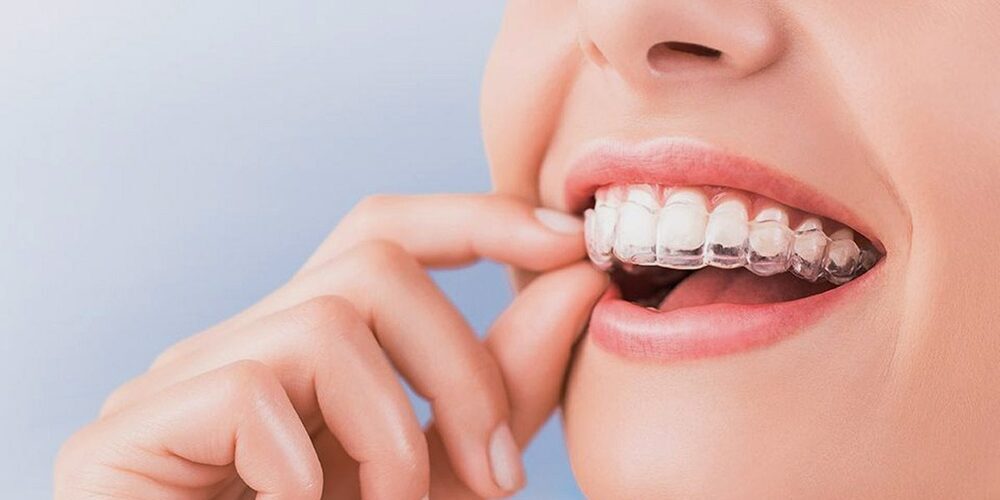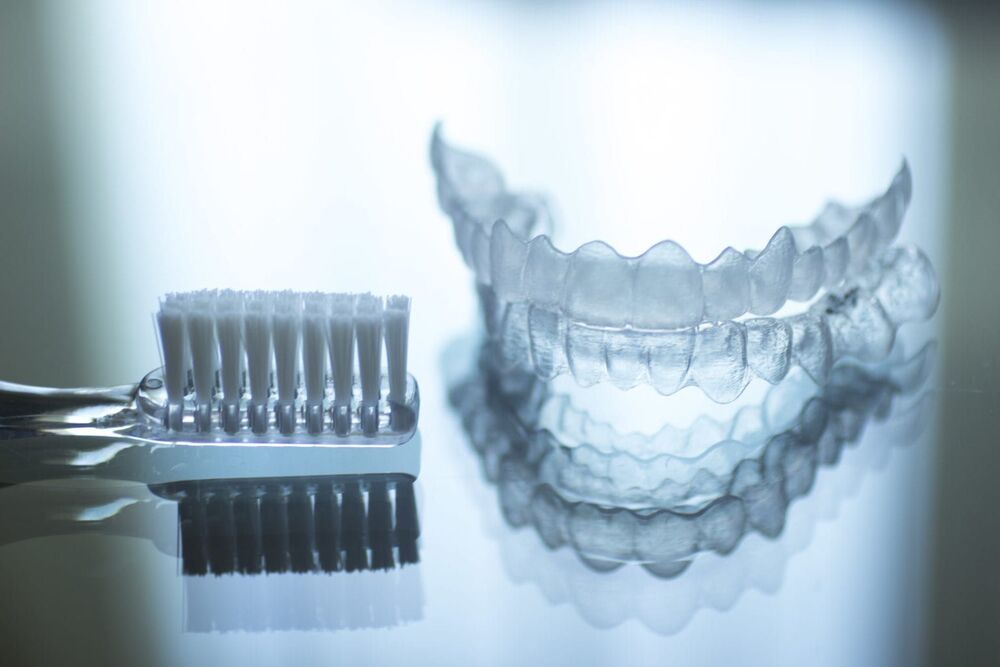
Clear Aligner Treatment (Brace-Free Orthodontics)
Brace-free orthodontics, also known as clear aligner treatment, is a revolutionary approach that substitutes traditional metal or ceramic braces. In this method, personalized clear aligners, crafted using 3D printers, deliver orthodontic treatment tailored to an individual’s specific needs.
Advantages of Clear Aligner Treatment (Brace-Free Orthodontics)
Brace-free orthodontics, the pinnacle of aesthetic satisfaction, offers orthodontic treatment without the visible wires associated with traditional braces. Let’s delve into the advantages of clear aligner treatment:
Flexibility: Removable clear aligners allow for flexibility in treatment, accommodating interruptions as needed.
Reduced Discomfort: Unlike traditional braces that exert continuous force on teeth for prolonged periods, often leading to discomfort, clear aligners minimize this discomfort. Weekly aligner changes ensure minimal pain and discomfort.
No Cheek or Lip Irritation: Clear aligners eliminate the potential for irritation caused by contact with metal surfaces, a common issue with traditional braces.
Improved Oral Health: Clear aligners can be removed during meals, reducing the risk of tooth decay and plaque buildup.
Convenient Dining: The ability to remove clear aligners while eating enhances their usability.
Aesthetically Pleasing: Clear aligners are virtually invisible when worn, providing superior comfort from an aesthetic perspective.
Faster Results: In some cases, clear aligner treatment can yield quicker and more straightforward results.
Enhanced Confidence: As they are removable, clear aligners boost confidence during meetings or events, allowing for improved speech and appearance.
Disadvantages of Clear Aligner Treatment
The removable nature of clear aligners can occasionally lead to misplacement or loss. To prevent this, it is advisable to store them in their designated case when not in use. Furthermore, consistent use is essential, with aligners worn for a minimum of 22 hours daily to achieve the desired results.
When is Clear Aligner Treatment Applicable?
Brace-free orthodontics can be applied in various cases, including issues like misaligned jaws, crooked teeth, gaps, or narrow jaws.
How is Clear Aligner Treatment Conducted?
The process begins with an examination by an orthodontist. Intraoral scans are taken using an intraoral scanner to record the jaw and bite. Custom-designed clear aligners are created in 3D. A simulation of the post-treatment appearance is prepared, approved by the orthodontist, and then the aligners are printed. Patients are provided with multiple aligners, which are replaced according to the orthodontist’s recommended schedule.
Can Teeth Move Without Braces Using Clear Aligners?
In clear aligner treatments, teeth may move more rapidly in some cases compared to traditional braces. In other cases, they may move at the same rate but with greater comfort.
Preparation for Clear Aligner Treatment
Before starting any orthodontic treatment, any existing oral problems must be addressed. A general examination should be conducted, and any existing issues like tooth decay or cavities should be treated. Good oral hygiene should be maintained before commencing brace-free orthodontic treatment.
Post-Treatment Care for Clear Aligners
To minimize the risk of teeth shifting back to their original positions after treatment, patients should use retainer plates as recommended by their orthodontist. Patience and consistency are vital in maintaining the desired results.
Is There an Age Limit for Clear Aligner Treatment?
Brace-free orthodontics can be suitable for both teenagers and adults. Typically, it can be applied once all baby teeth have fallen out, and permanent teeth have largely erupted, usually after the age of 12-14. There’s no upper age limit, but patients should have healthy gum tissues and adequate bone support.
At What Age Can the Treatment Be Initiated?
This treatment is preferred for teenagers and adults, typically after the eruption of all permanent teeth. There’s no upper age limit.
How Many Hours Should Clear Aligners Be Worn Daily?
Clear aligners should be worn for approximately 22 hours per day. They should only be removed during meals and while brushing teeth. Reduced usage may lead to slower results.
What Happens If Clear Aligners Are Forgotten?
It’s recommended to use clear aligners for 22 hours daily. Reduced usage diminishes the likelihood of successful treatment.
Is Clear Aligner Treatment Painful?
Patients usually experience minimal discomfort during this treatment. Pain associated with clear aligners is much less compared to traditional orthodontic treatments. Discomfort is most commonly felt during the first few days after changing aligners.
How Long Does The Treatment Take?
The duration of clear aligner treatment varies depending on an individual’s dental structure, treatment needs, and desired outcomes. Generally, treatment can take anywhere from 6 months to 2 years. However, some simple cases may yield results more quickly, while complex cases may require a longer treatment period.
How Often Are Clear Aligners Changed?
Aligners are typically changed every 1 to 2 weeks. However, the frequency of change can vary based on the specific treatment and the treatment plan. In some cases, where more complex tooth movements are needed, aligners may be worn for up to 2 weeks at a time. Conversely, in simpler cases, aligners may be changed every week.
What Foods Should Be Avoided ?
Unlike traditional braces, clear aligners can be removed when eating and drinking, allowing for greater dietary freedom.
Does It Affect Speech?
Initially, there may be a slight adjustment period when speaking with clear aligners. However, this typically fades over time as the mouth adapts.
Does Excessive Consumption of Coffee, Tea, or Smoking Affect Clear Aligners?
Long-term use of clear aligners may lead to discoloration due to substances like coffee, tea, fruit juice, or smoking. However, because aligners are changed every 1 to 2 weeks during treatment, discoloration is generally not an issue.

For an effective treatment, clean aligners should be cleaned routinely.
How to Clean Clear Aligners?
Here are some steps for cleaning clear aligners:
- Wash Your Hands: Before cleaning, thoroughly wash your hands with soap and water.
- Rinse with Lukewarm Water: Remove the aligners and rinse them with lukewarm water. Avoid using hot water, as it may warp the aligners.
- Use a Soft Brush: Gently brush the aligner’s surface using a specialized clear aligner cleaning brush or a soft toothbrush. Avoid excessive pressure to prevent scratching.
- Consider Cleaning Tablets: Specialized cleaning tablets are available for clear aligners. Follow the instructions on the package or consult your orthodontist for guidance.
- Store in a Case: After cleaning, store the aligners in their designated case to keep them clean and maintain their shape.
- Avoid Toothpaste and Mouthwash: Avoid using toothpaste or mouthwash on your aligners, as these can scratch and dull the surface.
- Rinse Before Reinserting: Before reinserting the aligners, rinse them with water to remove any cleaning solution residue.
- Follow Professional Advice: Always follow your orthodontist’s recommendations for proper cleaning and maintenance of your clear aligners.
How Often Should Check-Ups Be Scheduled?
Unlike traditional orthodontic treatments that require monthly check-ups, clear aligner treatment planning allows for longer intervals between appointments. Typically, check-ups are scheduled at the beginning, middle, and end of treatment. Fewer check-ups make this treatment option convenient for patients living outside the city or even abroad.
Can Clear Aligners Be Used After Braces?
Clear aligners can be used after traditional braces as part of a retention plan to maintain the results achieved during orthodontic treatment. Similarly, clear aligners can be used for retention following clear aligner treatment.
Are Retainers Used in Clear Aligner Treatment the Same as Retainers Used After Braces?
No, “retention treatment” and “clear aligner treatment” are distinct concepts.
Retention Treatment (Retainer Treatment):
Retention treatment aims to maintain the correct positions achieved after orthodontic treatment. It is often performed using retainers, which can be fixed or removable. Retainers are used to prevent teeth from shifting back to their original positions after treatment, ensuring that the desired results remain stable.
Clear Aligner Treatment:
Clear aligner treatment is employed to align and correct teeth. Custom-made clear aligners are used to gently move teeth into the desired positions over time.
So, while retention treatment focuses on maintaining results post-treatment, clear aligner treatment is geared toward aligning and correcting teeth.
Which Brands Are Used?
In the market for clear aligner treatments, Invisalign and Orthero are the preferred choices. Both have different production technologies.
Invisalign is the oldest and leading company in the orthodontic industry, known for its advanced technology. It tends to be more expensive than Orthero.
Orthero is a Turkish company and a pioneer in bringing computer-assisted clear aligner treatment to our country.
At our clinic, we prefer Invisalign. However, the choice between Invisalign and Orthero depends on various factors, and it’s advisable to consult your orthodontist for guidance.
